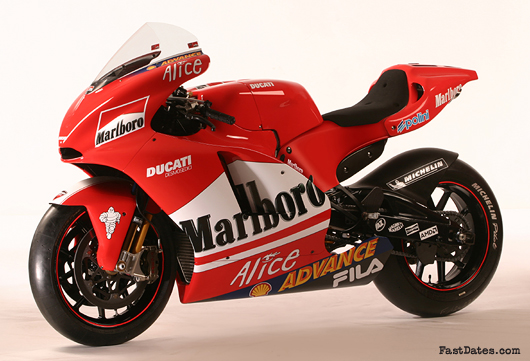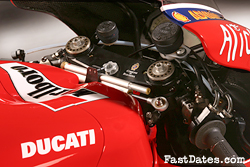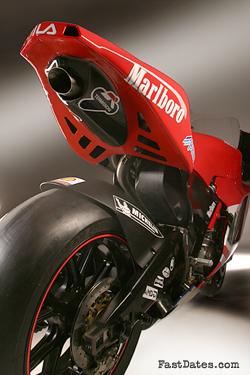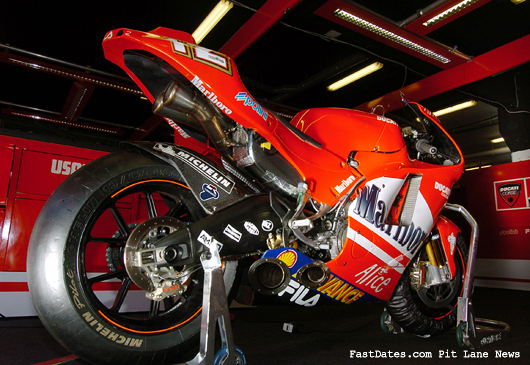|

Left to right: Ducati president Frederico Minoli, team director Claudio Domenicali, rider Troy Bayliss, team manager Dario Raimondi, and rider Loris Capirossi.
Ducati Desmosedici 2004 MotoGP - D16 GP4
Bolonga, Italy, February 1st, 2004 - Right out of the box the first 2003 season Desmosedici proved to be a competitive bike, even demonstrating areas of excellence against rivals with more experience.
The Desmosedici project capitalized on Ducati Corseís four-stroke competition experience in years of World Superbike success. Guided by the knowledge that lap times are the only sure-fire sign of competitiveness, Ducati Corse engineers organized the project right from the start with the aim of creating a prototype that combined their experience with the new possibilities offered by the MotoGP regulations. The data acquired by the Ducati Marlboro Team during the 2003 season in 16 GPs and over 30 days of testing carried out by Capirossi and Bayliss, and the development team with Vittoriano Guareschi (more than 30,000 kms last year), have enabled the engineers to better understand the areas where improvements can be made for the 2004 version.
Many changes
have been carried out. More than 60% of the 915 individual components
that make up the new bike are totally different and cannot be
interchanged with the previous version. "The experience we
gained in 2003 was fundamental for the creation of the GP4î
explains Filippo Preziosi, Ducati Corse Technical Director. ìWith
the aim of improving the bikeís overall performance and
rider comfort, we intervened in various areas of the chassis and
the engine. The result is a major evolution of last yearís
bike. The project is very young and it is natural that in this
phase, the changes will make the GP4 considerably different to
the GP3, albeit remaining faithful to the basic philosophy."
"Last
year was a learning season for us," declares Ducati Corse
Managing Director Claudio Domenicali. "We had to learn everything
about the new bike, which often raced on tracks that we had never
seen before. Loris immediately adapted to four-strokes and our
working method, and right from the start gave us some great results
and real excitement. Troy had to learn numerous circuits and change
his riding style to MotoGP power, but adapted quickly and his
three podiums are a demonstration of this. The results obtained
confirm that the project has solid foundations, on which we must
continue to grow, and we feel that we are stronger than one year
ago.
Our working
group, from Loris and Troy to all the guys in the company, has
demonstrated a devotion and professionalism that fills us with
pride. All this would not have been possible without the support
and the trust of our partners. First of all Marlboro, which believed
in us right from the start; Shell Advance, with whom we have a
long-standing technical partnership; and Fila and Michelin to
name just a few. A warm welcome also to our new partners, including
Alice, the prestigious Telecom Italia brand with whom we have
also started collaborating on a company telecommunications level.
I am sure that the season that is about to get underway will see
us contenders in a World Championship that on paper is very evenly
balanced and for this reason even more exciting. We are starting
the season with the knowledge that we have grown up but aware
that the project is still young and in its development phase".
Loris Capirossi
and Troy Bayliss are ready to face up to this new challenge. Last
year both confirmed themselves to be at the top of their game
and capable of giving 100% on every occasion."

The D16 GP4 has numerous differences in the following areas:
Bodywork: outwardly similar to the previous version, the bodywork has been completely redesigned
in order to improve cooling while maintaining the bikeís excellent aerodynamic characteristics.
It is also made up of four components instead of two in order to improve access for the mechanics.
Front mudguard: a new larger front mudguard improves the aerodynamics and increases airflow towards the radiator.
Front fork: the front fork maintains the stiffness of the latest 2003 version, but uses 42mm instead of 50mm
forks, which enables weight to be saved.
Exhaust system: the exhaust system is produced in titanium by Termignoni and has been completely
redesigned. It sports two ëtwo-into-oneí pipes, with the vertical cylinder head arrangement
terminating under the tail unit, like last year and in the best Ducati tradition. The horizontal cylinder arrangement terminates on the right of the bodywork. The new exhaust lay-out has enabled the fuel tank to be modified and furthermore has been designed to improve power delivery.
Fuel tank: this extends under the seat to improve centralization of the masses. It sports an indentation in the front part, which contains the main electrical components. This modification has also been made to centralize
the masses.
Swing-arm: in pressed aluminium, this has been completely redesigned and is lighter than the previous version
while retaining the same stiffness.
Frame: tubular steel frame, typical of all Ducati production. The 2004 version is different in the engine
mountings, making it easier to assemble and remove the engine itself. The dimensions are the same as the 2003 version.
Airbox: the airbox is larger than the previous version, thus contributing to an increase in power and a difference in the torque curve.
Engine: the engine has a new combustion chamber and a number of changes have been made to reduce internal attrition. Further changes have also been made to reduce weight. The result is more power (now in excess
of 230 HP at 16,500 rpm, an increase of around 10 HP and 500 rpm on the 2003 version).
Electronics: Magneti Marelli electronic hardware is the same as 2003 but new software has been developed. | "All the technical partners with whom we are in contact daily have contributed in a decisive way to the development of the Desmosedici and the increase in performanceî comments Filippo Preziosi. ìTo mention just two, Shell Advance, together with whom we develop lubricants capable of improving the performance and reliability of our engine, and Michelin, with whom, amongst other things, we are developing 16.5î front tyres, which have been used successfully for many years by Ducati Corse in Superbike." |
 |
This evolution will continue throughout the racing season on Ducati Corse test-benches and on computers, guaranteeing not only a continuous improvement in performance, but also a constant increase in Ducati know-how, which will be used for the development of road-bikes, as in the best tradition of the Bologna manufacturer. | 
| 
A Nice Tight Rear
At left, the 2003 GP3 machine with twin tail pipes exiting
the open rear tail section. Above, the new 2004 GP4 bike
has a smaller, more aerodynamic tail piece with a single
exhaust tail pipe. Note the lowered fuel tank above the
swingarm and rerouted exhaust pipe.
Below: 2004 Desmosedici Twin Pulse with 4 pipes.
|
 Above:
The new 2004 Twin Pulse MotoGP 4 introduced in mid season in June
2004.
The
sight of four exhaust pipes on the new Ducati Twin Pulse MotoGP04
with one per 4 valve cylinder, the rear 2 cylinders exhausts exhiting
under the sea, t and the front cylinders under the swingarm,really
looks agressive. Click for a better view. Above:
The new 2004 Twin Pulse MotoGP 4 introduced in mid season in June
2004.
The
sight of four exhaust pipes on the new Ducati Twin Pulse MotoGP04
with one per 4 valve cylinder, the rear 2 cylinders exhausts exhiting
under the sea, t and the front cylinders under the swingarm,really
looks agressive. Click for a better view.
Ducati's
Revised Mid-Season Twin-Pulse Desmosedici
MotoGP
Bike
Ducati Corse
Press, Catalunya (Spain), Monday 14 June 2004 - The new Twin Pulse
engine that was given its shakedown last week at Mugello by factory
tester Vittoriano Guareschi, was used for the first time today
by both Ducati Marlboro Team riders, who stayed behind at the
MontmelÚ circuit the day after the Catalunya Grand Prix.
Loris Capirossi
and Troy Bayliss backed up the positive view expressed by Vittoriano:
that the new engine, with its irregular firing order, represents
a step forward over the previous version. It improves 'rideability'
and allows the riders to have better consistency in their performance.
Both Capirossi
and Bayliss, who did not focus on setting quick times, used the
day's testing solely to gain confidence with the 'Twin Pulse'
and its behaviour. Weather conditions today were good (25∞C
air/41∞C track), mainly sunny with a few drops of rain that
did not interfere with the testing.
After 72 laps out on the track and a best time of 1'44.5, Loris
Capirossi was pleased with today's work. The Italian rider also
carried out back-to-back testing with the engine used during the
weekend. "
'I am pleased
with what we did today: I enjoyed myself on my bike again and
we worked really well during this first test for the new engine",
declared Loris. "Compared with the previous version, the
Twin Pulse has greater potential. Of course we have to get to
know all about it and test it again, in particular to adapt the
settings and the gear ratios to its characteristics, but I think
that we can be satisfied with the first day. I can't wait to get
back to being one of the front-runners again!"
Despite yesterday's
spectacular crash, Troy Bayliss got back onto his Desmosedici
GP4 late in the morning and completed 46 laps of the track, the
best time being 1'45.0. His pace was also good, quicker than the
times set during Sunday's race. Despite still being in a bit of
pain, the Australian was also satisfied with the new engine.
"I like the Twin Pulse, it's a lot better than the engine
we've used up to now", commented Bayliss. "It makes
the bike easier to ride and I feel a lot more comfortable on it:
just look at my times, they are good today despite me not being
in perfect shape. Tomorrow morning I'll see how I feel and decide
whether to continue testing or go back home for a rest'.
June 15th: The second and final day of testing for the Ducati
MotoGP Team at the Montmelò Circuit, Catalunya, was cut
short by changeable weather conditions. Heavy showers during the
morning meant that Loris Capirossi was unable to lap with any
consistency, but the Italian did go out on the track for several
laps to gauge the behaviour of the new engine in the wet. Team-mate
Troy Bayliss, who crashed spectacularly during Sunday’s
race, opted not to continue testing today and returned home this
morning to get back into shape as quickly as possible. Loris Capirossi
only completed a few laps in the wet, but this was sufficient
to confirm yesterday’s positive sensations: the new engine
considerably improves the bike’s ‘rideability’,
a characteristic that Loris particularly appreciated given the
characteristics of the track.
“We
are really pleased with the debut of the new Twin Pulse engine,”
declared Ducati MotoGP Team Director Livio Suppo. “Loris
confirmed that power delivery has improved, even in the wet, and
we are preparing for Assen with renewed optimism. I am convinced
that Troy, after a few days of rest, will be in perfect shape
in the Netherlands and we can’t wait to get back out on
the track again. The first races of the 2004 season have not been
easy, but Ducati Corse is showing that it has a capacity to react
quickly and a determination to become protagonists once again
that I feel sure that we will soon be rewarded with results.”
The new irregular
firing order Twin Pulse engine has met with approval since being
tested at Mugello and, as confirmation of this, both Ducati MotoGP
Team riders will use the new engine in the Dutch TT at Assen.
Editor's
Note; When the V-4 Desmosedici was first developed in 2002 it
was tested in a V-Twin style "Twin Pulse" tandum piston
stroke and firing order on each bank to give it the successful
power impulse of Ducati's V-2 Superbike engines. It was also tested
with s a conventional 90-degree firing order with staggered piston
/ crank pin placement. The origional Twin Pulse design and tandem
firing order proved to be too violent on the lightweight GP engine
design's reliability and was never raced. This new Twin Pulse
engine for 2004 retains the old tandem crank/piston movement per
cylinder bank, but the firing order is now 180 degrees apart per
cylinder to stagger the power impulses evenly over the 720 degrees
rotation of a 4-stoke engine to fire a cyclinder and not overstress
the engine.
| The Desmosedici GP4 Engine
Ducati’s long-favoured 90-degree ‘L’ configuration offers advantages that have also contributed to the factory’s racetrack successes. The layout provides intrinsic engine balance, a fundamental consideration in an engine that revs at over 16,000rpm, and minimum vibration, good for mechanical efficiency and reliability. The desmo system, designed by legendary Ducati engineer Fabio Taglioni, uses rockers to close as well as open valves, allowing particularly accurate valve operation, whatever the rpm. Desmo-driven valves also offer minimum power loss, especially in the low-to-medium rpm range, compared to other timing systems, especially pneumatic. The Desmosedici's GP4 engine has a new combustion chamberand a number of changes have been made to reduce internal attrition. Further changes have also been made to reduce weight. The result is more power (now in excess of 230 HP at 16,500 rpm, an increase of around 10 HP and 500 rpm on the 2003 version).
The airbox is larger than the previous version, thus contributing to an increase in power and a difference in the torque curve.
|
 |

Get
Awesome full-screen Desmosedici and Superbike Screensavers in
Paddock
Garage
Return to • Ducati
Index • Pit
Lane News
|
